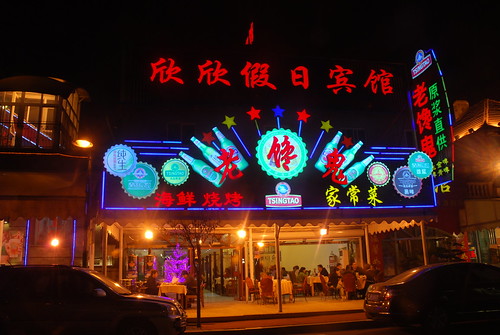Beervana
Qingdao is China’s premier “beer” city, as the country’s most famous brew – Tsingtao – was founded and continues to be brewed here. (For those who do come to the city, Tsingtao makes a decent dark beer – Yuan Jiang – that is quite hard to get outside of the city.) I guess the easiest comparison I can make would be to say that Qingdao is the same to beer culture here as St. Louis and Milwaukee are in the United States; a town famous for a mass-produced beer.
The Tsingtao brewery and museum (slightly underwhelming, according to my Lonely Planet guidebook) is located on Dengzhou Lu a bit north of Zhongshan Park. Dengzhou Lu is also famously known as Pijiu Jie (Beer Street). During the day, it’s easy to see the nightlife potential. At night, almost every establishment along this stretch of Dengzhou Lu (probably about a half kilometer to a one kilometer long) is a restaurant that opens up with the focus on drinking beer – almost always Tsingtao. (Curiously, in coming by here at night, the taxi took me past Hongjiu Jie – Red Wine Street. It looked quite a bit less subdued as wine culture here is, well, nonexistent. I didn’t have a chance to get back and look around there. Having drunk Chinese wine before…I don’t think I’m missing too much.)
I’ve lived in China for almost three years now; about two years in Shanghai and one year in Tianjin. Shandong province is the province that’s on the sea between the two cities. (From Shanghai to Tianjin by train is around 5 hours; by plane, 2 hours.) Qingdao, probably the most well-known city in Shandong, is a charming city, to say the least. In my opinion, it’s exceptionally photogenic – with very nice beaches, great architecture, good geography/topography, and terrific food.
Qingdao also happens to be known for the most famous of Chinese beers (Tsingtao), which is actually a company started by the Germans. (For what it’s worth, Chinese beers are quite watery and Tsingtao is somewhat like the Budweiser of Chinese beers. That being said, I’m happy to drink an ice cold Tsingtao on a hot summer day whereas I wouldn’t say the same thing about a Budweiser.
So what to make of Qingdao then? Before colonial powers swept in and started chopping up China piecemeal, Qingdao was basically a sleepy fishing village. During the Ming dynasty, a battery was built here. In 1898, the Germans seized control of Qingdao when two missionaries were killed. (Personally, it seems alarming to me that a country could lose a city because two foreigners happened to be killed – and China sure lost a lot that way during the 19th century. I guess that’s the downside to outmoded military technology; the Europeans and Americans basically plundered China…) At any rate, Qingdao was ceded to the Germans for 99 years, but that didn’t last long, thanks to World War I.
During the 15-20 years that the Germans did have control of the town, they managed to build a handful of churches (still standing) and missionaries, in addition to the aforementioned Qingdao brewery. Because of that, a lot of the European architecture has a heavy German influence and there are still a few random signs of German heritage around town.
From the Germans, Qingdao didn’t land directly with the Chinese. It spent 8 years under Japanese control (1914-1922) before being returned to the Kuomintang (aka General Chiang Kai-Shek’s clan). The Japanese took control once again in 1938 (as they swept through northeast China and across half the country) before losing it for the last time in 1945 at the end of World War II. Since then, it’s been in Chinese hands. (Brief history courtesy of Lonely Planet.)
Contemporary Qingdao certainly makes its way as a tourist destination – and it’s a fine one at that. The population (per my LP from 2011) lists it at 1.73 million. The city has a few areas that are quite appealing to tourists: the Old Town (the heart of the city) off the beach and just east of the railway station downtown, Badaguan (which means “eight passes”) is a hilly area with a lot of nice residential architecture to the east of the Old Town. Other than that, there are a lot of parks, a beer street, churches, and a 40 km. scenic walk (which, obviously, most people do not cover from end to end) along the shore which goes by all of the beaches in the area.
All in all, Qingdao is the type of town that, if you get the chance to visit, I think you would find yourself thinking it would be great to return again and again.
Posted by Neil Noland on 2014-05-29 04:10:58
Tagged: , Qingdao , Shandong , China , Beer_Street
Advertise your bike business at Bikes n Customs
#bikesncustoms
